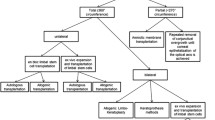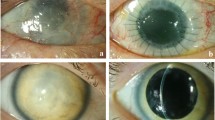Abstract
Background
The aim of this study was to retrospectively analyse the outcome of a series of grafted patients over a period of more than 10 years and to determine their long-term survival probability.
Methods
The records of 89 patients who had 103 grafts performed in 97 eyes were analysed. Mean follow-up was 12.8 years (range 10–17 years). Life table analysis (Kaplan–Meier) was used to evaluate the graft survival of the total population and of different groups.
Results
Eighteen out of 89 patients (20.2%) had died. At the last visit before their death, 10 of the 21 grafts in those patients were still clear. Graft survival rates after 1, 2, 5 and 10 years were 79%, 73%, 59% and 50%; the rate at the end of follow-up was 47%. Survival rate at the end of the study was 94.7% for keratoconus, 57.1% herpes keratitis, 33.3% for pseudophakic keratopathies, 28.5% for post-traumatic keratopathies and 11.1% for re-grafts. In the group of patients grafted for aphakic or pseudophakic keratopathy, 40% died during the study. In 45% of cases their grafts were clear at the time of death. Endothelial decompensation and definitive graft rejection were the main causes of failure.
Conclusions
The outcome of keratoplasty is progressively getting worse with time in pseudophakic or traumatic keratopathies whereas survival rates are still stable from 10 to 17 years in grafts performed after keratoconus or herpetic keratitis.







Similar content being viewed by others
References
Bishop VL, Robinson LP, Wechsler AW, Billson FA (1986) Corneal graft survival: a retrospective Australian study. Aust N Z J Ophthalmol 14:133–138
Borderie V, Laroche L, Vedie F, Lopez M (1995) Penetrating keratoplasty after graft preservation in organ culture at +37 degrees centigrade. 1-year results. J Fr Ophtalmol 18:570–577
Borderie VM, Touzeau O, Allouch C, Scheer S, Carvajal-Gonzalez S, Laroche L (1999) The results of successful penetrating keratoplasty using donor organ-cultured corneal tissue. Transplantation 67:1433–1438
Chell PB, Hope-Ross MW, Shah P, McDonnell PJ (1996) Long-term follow-up of a single continuous adjustable suture in penetrating keratoplasty. Eye 10:133–137
Dandona L, Naduvilath TJ, Janarthanan M, Ragu K, Rao GN (1997) Survival analysis and visual outcome in a large series of corneal transplants in India. Br J Ophthalmol 81:726–731
Ficker LA, Kirkness CM, Rice NS, Steele AD (1988) Longterm prognosis for corneal grafting in herpes simplex keratitis. Eye 2:400–408
Ficker LA, Kirkness CM, Rice NS, Steele AD (1989) The changing management and improved prognosis for corneal grafting in herpes simplex keratitis. Ophthalmology 96:1587–1596
Ing JJ, Ing HH, Nelson LR, Hodge DO, Bourne WM (1998) Ten-year postoperative results of penetrating keratoplasty. Ophthalmology 105:1855–1865
Jonas JB, Rank RM, Budde WM (2002) Visual outcome after allogenic penetrating keratoplasty. Graefes Arch Clin Exp Ophthalmol 240:302–307
Karesh JW, Nirankari VS (1983) Factors associated with glaucoma after penetrating keratoplasty. Am J Ophthalmol 96:160–164
Kornmehl EW, Steinert RF, Odrich MG, Stevens JB (1990) Penetrating keratoplasty for pseudophakic bullous keratopathy associated with closed-loop anterior chamber intraocular lenses. Ophthalmology 97:407–412
Kus MM, Seitz B, Langenbucher A, Naumann GO (1999) Endothelium and pachymetry of clear corneal grafts 15 to 33 years after penetrating keratoplasty. Am J Ophthalmol 127:600–612
Lois N, Cohen EJ, Rapuano CJ, Laibson PR (1997) Long-term graft survival in patients with flexible open-loop anterior-chamber intraocular lenses. Cornea 16:387–392
Lomholt JA, Baggesen K, Ehlers N (1995) Recurrence and rejection rates following corneal transplantation for herpes simplex keratitis. Acta Ophthalmol Scand 73:29–32
Mannis MJ, Zadnik K, Miller MR, Marquez M (1997) Preoperative risk factors for surface disease after penetrating keratoplasty. Cornea 16:7-11
Pineros O, Cohen EJ, Rapuano CJ, Laibson PR (1996) Long-term results after penetrating keratoplasty for Fuchs' endothelial dystrophy. Arch Ophthalmol 114:15–18
Price FW Jr, Whitson WE, Collins KS, Marks RG (1993) Five-year corneal graft survival. A large, single-center patient cohort. Arch Ophthalmol 111:799–805
Reinhard T, Kallmann C, Cepin A, Godehardt E, Sundmacher R (1997) The influence of glaucoma history on graft survival after penetrating keratoplasty. Graefes Arch Clin Exp Ophthalmol 235:553–557
Sharif KW, Casey TA (1991) Penetrating keratoplasty for keratoconus: complications and long-term success. Br J Ophthalmol 75:142–146
Spadea L, Cifariello F, Bianco G, Balestrazzi E (2002) Long-term results of penetrating keratoplasty using a single or double running suture technique. Graefes Arch Clin Exp Ophthalmol 240:415–419
Tuft SJ, Gregory W (1995) Long-term refraction and keratometry after penetrating keratoplasty for keratoconus. Cornea 14:614–617
Vabres B, Duffas M, Stork L, Pechereau A (1999) Non-immunologic factors of failure of penetrating keratoplasties. Prospective study of 119 corneal grafts at the Nantes Hospital Center in 1995. J Fr Ophtalmol 22:33–38
Vail A, Gore SM, Bradley BA, Easty DL, Rogers CA, Armitate WJ (1996) Clinical and surgical factors influencing corneal graft survival, visual acuity, and astigmatism. Corneal Transplant Follow-up Study Collaborators. Ophthalmology 103:41–49
Vail A, Gore SM, Bradley BA, Easty DL, Rogers CA, Armitage WJ (1997) Conclusions of the corneal transplant follow up study. Collaborating Surgeons. Br J Ophthalmol 81:631–636
Waldock A, Cook SD (2000) Corneal transplantation: how successful are we? Br J Ophthalmol 84:813–815
Williams KA, Ash JK, Pararajasegaram P, Harris S, Coster DJ (1991) Long-term outcome after corneal transplantation. Visual result and patient perception of success. Ophthalmology 98:651–657
Williams KA, Muehlberg SM, Lewis RF, Coster DJ (1997) Long-term outcome in corneal allotransplantation. The Australian Corneal Graft Registry. Transplant Proc 29:983
Yamagami S, Suzuki Y (1996) Risk factors for graft failure in penetrating keratoplasty. Acta Ophthalmol Scand 74:584–588
Zacks CM, Abbott RL, Fine M (1990) Long-term changes in corneal endothelium after keratoplasty. A follow-up study. Cornea 9:92–97
Zaidman GW, Goldman S (1990) A prospective study on the implantation of anterior chamber intraocular lenses during keratoplasty for pseudophakic and aphakic bullous keratopathy. Ophthalmology 97:757–762
Acknowledgement
The authors thank Mr. Rousseau-Cunningham for his advice in editing the manuscript.
Author information
Authors and Affiliations
Corresponding author
Additional information
The authors hereby confirm that there were no financial or proprietary interests and no public or private support for this study
Rights and permissions
About this article
Cite this article
Muraine, M., Sanchez, C., Watt, L. et al. Long-term results of penetrating keratoplasty. Graefe's Arch Clin Exp Ophthalmol 241, 571–576 (2003). https://doi.org/10.1007/s00417-003-0691-z
Received:
Revised:
Accepted:
Published:
Issue Date:
DOI: https://doi.org/10.1007/s00417-003-0691-z




